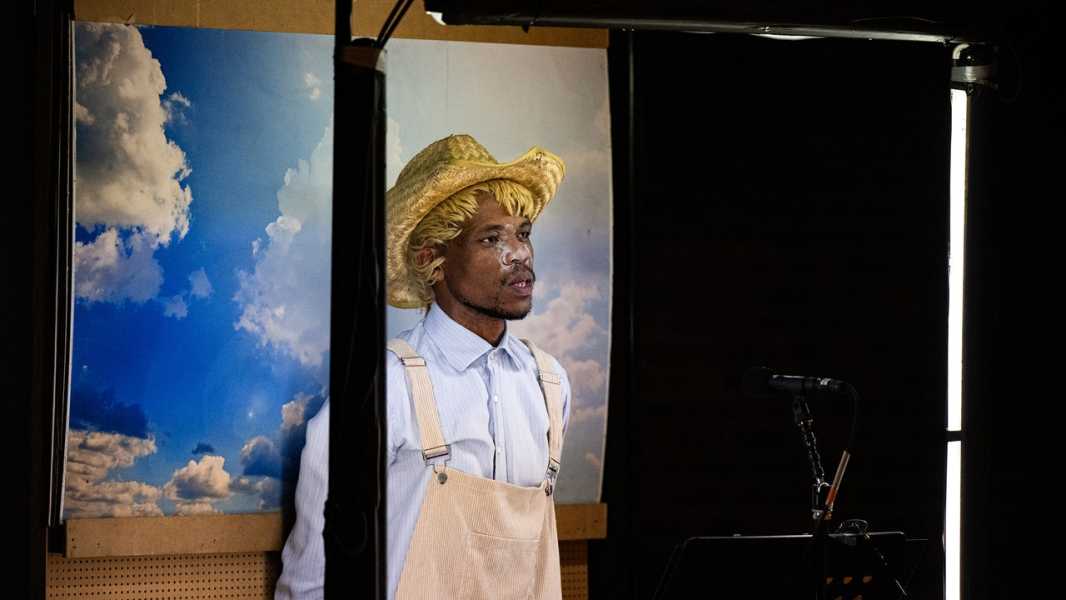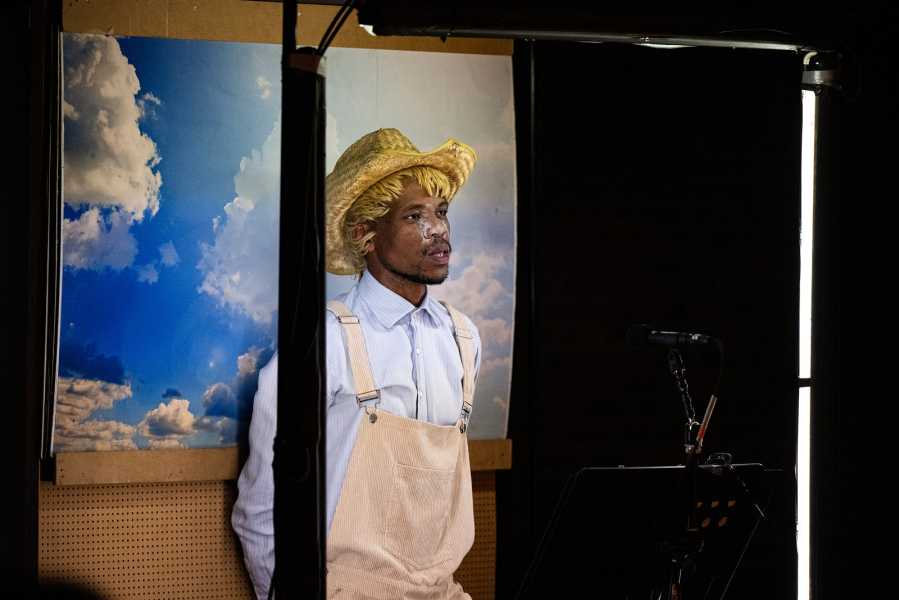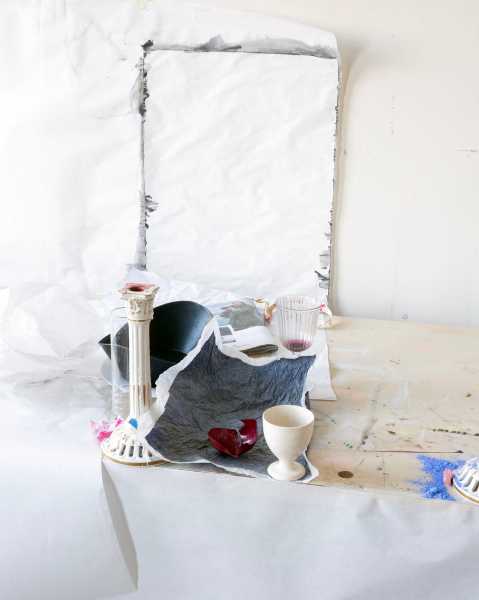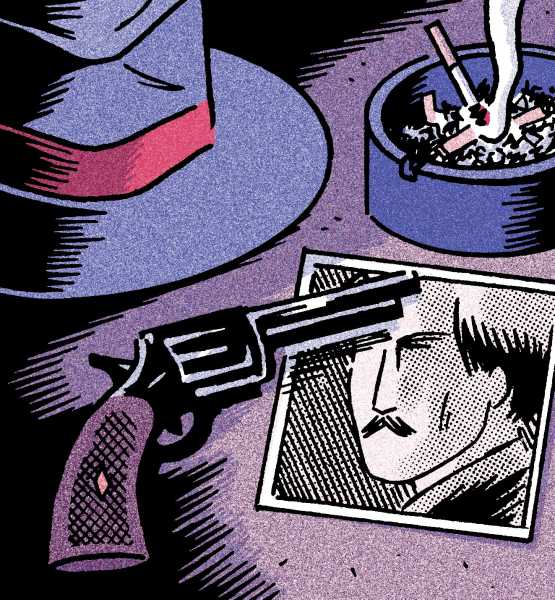
Save this storySave this storySave this storySave this story
Helen Shaw
Staff writer
You’re reading the Goings On newsletter, a guide to what we’re watching, listening to, and doing this week. Sign up to receive it in your in-box.
Walking to St. Ann’s Warehouse—a pretty brick industrial warehouse conversion in the Dumbo neighborhood—can show you Brooklyn at its most romantic: first, you’ll see sunshine slanting onto cobblestone streets, then Brooklyn Bridge Park’s soft paths, then the East River, with Lower Manhattan shimmering beyond. Inside the theatre, though, you’ll find the country at her blood-soaked worst. A shock of the awful is the key to the horror-movie-style excitement of “Dark Noon,” a brutally clownish retelling of European settlers’ push into the American West which St. Ann’s artistic director, Susan Feldman, first saw at the Edinburgh Fringe. A troupe of seven South African actors, many wearing slapped-on whiteface and yellow mop wigs, exhort the audience via live video and carnival-barker shouting—don’t sit in front unless you want to be hustled into service—as the decades (Slavery! Civil War! Gold rush!) zoom past.

Photograph by Teddy Wolff
It’s not all history, though, and the supposedly American aspect also shifts, at times, into South African self-portraiture. “Dark Noon” is the work of the Danish writer-director Tue Biering, in collaboration with both the South African cast and the co-director, Nhlanhla Mahlangu. Mahlangu has said that the show’s town—a take on Western movie sets, built, as we watch, with folding frames and a working railway—also recalls the apartheid-era squatter camps of home. The two countries rhyme, of course, in other ways, too. At one point, each actor addresses a camera, confessional style, to talk about the impact of U.S. Westerns on South African youth: “Many people in my township died by the gun,” the performer Lillian Tshabalala-Malulyck says, noting how the films exported a gamified violence. A human being plays a rolling tumbleweed; members of the audience play a terrorized boomtown congregation as gunfire explodes in the street; eventually, almost everybody plays dead. Pow pow pow goes a pistol, and a Native warrior falls down. But it isn’t enough to kill the Indigenous defender once—oh, no. The shooter takes aim, and kills him over and over and over again.

About Town
Classical
Amid method-dressed press appearances for the upcoming “Wicked” movie, Cynthia Erivo is gracing us with a little Sondheim. The venerated singer and actress, who is one “O” shy of an EGOT, will join other distinguished performers, including the mezzo-soprano Susan Graham and the seasoned Frankenstein’s monster Shuler Hensley, to mount “A Little Night Music” in concert, at Lincoln Center. An expanded Orchestra of St. Luke’s accompanies, conducted by Sondheim’s longtime orchestrator of choice, the full EGOT Jonathan Tunick, in a run that is sure to be glamorous.—Jane Bua (David Geffen Hall; June 27-29.)
Rock
In the late twenty-tens, the singer-songwriter David Bazan started to take Pedro the Lion, the indie-rock band he founded in Seattle, in 1995, on a spiritual tour of cities that had shaped his creative output. The band cohered in the two-thousands around thematic albums that put the inner lives of both callous and guilt-stricken capitalists into striking relief, but its members split in 2006. Bazan now jump-starts Pedro the Lion once more, exploring echoes of his childhood homes across a planned five-album series. Following “Phoenix” (2019) and “Havasu” (2022) is the recently released “Santa Cruz,” a nostalgic record that reflects on the transition into young adulthood. The music is at once clear-eyed and eye-opening.—Sheldon Pearce (Music Hall of Williamsburg; July 1.)
Art

“leaning over blue,” 2023.
Photograph by Laura Letinsky / Courtesy Yancey Richardson
The Chicago-based photographer Laura Letinsky continues a career-spanning investigation of the tabletop still-life, a genre as old as photography itself (and centuries older in painting) but long out of fashion. No matter. Letinsky nods to its conventions—allegorical domesticity, elegant disarray—by undermining them. Working mostly in la Maison Dora Maar in the South of France, she lets the light of Provence bleach her prints to abstraction. What remains are after-dinner jumbles of dirty plates, crumpled napkins, and wilted flowers, with the tabletops teetering and all but dissolved in a white-on-white aura that never strains to be painterly. The party’s over, yet Letinsky sees not chaos but promise—and a genuine sense of renewal among the ruins.—Vince Aletti (Yancey Richardson; through July 3.)
Dance
Under the leadership of Michael Novak, the Paul Taylor Dance Company is trying new things, including shows at the intimate Joyce. Two alternating programs create wildly contradictory impressions of Taylor. On one end lies the cheerful classicism of “Airs,” set to Handel, and on the other the cynicism and savagery of “Big Bertha,” a theatrical miniature in which a seemingly happy family turns out to be rotten at the core. But other facets of the dancemaker also reveal themselves, in the avant-garde irresolution of “Post Meridian,” with color-block costumes by Alex Katz, and in the ritualistic drama of “Runes,” which evokes Taylor’s time as a dancer for Martha Graham.—Marina Harss (Joyce Theatre; June 25-30.)
Movies

Photograph by Kyle Kaplan / Courtesy Focus Features
Jeff Nichols’s film “The Bikeriders” is based on the photographer Danny Lyon’s book of the same title, from 1968, which documents Lyon’s four years of involvement with a Chicago motorcycle club. In the movie, Mike Faist plays Danny, whose personal ties are downplayed in favor of his observations—mainly of the camaraderie and the divisions that the club fosters. Its president, Johnny (Tom Hardy), keeps order with Machiavellian ferocity, but its coolest member, Benny (Austin Butler), whom everyone wants to follow, has no desire to lead. The film is structured around Danny’s interviews with a young woman named Kathy (Jodie Comer), who marries Benny; she offers a keen perspective on the physical and emotional toll of the club’s ambient violence and its ultimate devolution into a criminal gang. Nichols’s view of the characters is sometimes swoony, but his dramatic sense is sharp.—Richard Brody (In wide release.)
Theatre
Everything is fluid in “Pre-Existing Condition,” Marin Ireland’s gossamer-fragile aftermath play, directed by Maria Dizzia, about a woman, named A, shattered by an instance of intimate-partner violence. The carpeted non-setting cross-fades between apartment and therapist’s office; identities elide, too, so a lawyer refusing A’s case suddenly becomes her mom on the phone. Even the actors change. (I saw Tatiana Maslany as A; later, Dizzia and others will take her place.) People keep asking A what she wants—Someone to hit the guy back? Monetary damages?—but she doesn’t know. The play encourages unsettled, twilight thinking: we’re suspended between answers, as is A, so full of sorrow and bafflement, unable to chart her way past injustice.—Helen Shaw (Connelly Theatre Upstairs; through Aug. 3.)

Pick Three
The staff writer Alexandra Schwartz on her top hit-man movies.
1. The Cool Cat: Stoic, cunning, and inscrutable, Jef Costello (Alain Delon), the hunted hit man at the heart of Jean-Pierre Melville’s 1967 neo-noir classic, “Le Samouraï,” remains the unshakable archetype of the cinematic killer-for-hire. The film’s action is set in motion by a hit on a Parisian night-club owner which goes awry; as Costello is tracked through the city’s drizzly streets by both the police and the gangsters who paid him for the job, we root for this amoral killer to give them all the slip.
2. The Dumb Lug: Kinney, the hit man who roams through Elaine May’s pitch-black comic tragedy “Mikey and Nicky” (1976)—he’s out to get Nicky (John Cassavetes), a small-time Philadelphia mobster who’s stolen money from the boss—is the antithesis of French savoir-faire. Played by Ned Beatty, he’s constantly running two steps behind his target, foiled by, among other things, the city’s dearth of parking. “I look like a schmuck,” he complains to Nicky’s friend Mikey (Peter Falk), who’s been tipping him off. He’s not wrong.

Illustration by Lucas Harari
3. The Betrayer: Frank Sheeran (Robert De Niro), the eponymous protagonist of “The Irishman,” Martin Scorsese’s epic from 2019, works as a hit man for the Bufalino crime family and as a bodyguard for the Teamsters leader Jimmy Hoffa (Al Pacino). When Hoffa finds himself on the wrong side of the Mob, Sheeran is given the order to pull the trigger. Early in the film, Scorsese coats Sheeran’s violence with a comic, even glamorous veneer, but the brutal, blunt scene in which he murders his friend conveys the horror of the whole business.
P.S. Good stuff on the Internet:
- “Recess Therapy” is therapy for all
- “Pilgrim at Tinder Creek”
- It’s boring-girl summer
Sourse: newyorker.com